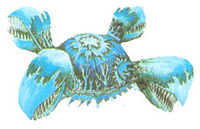Manhandla

| |
| Manhandla as seen in The Legend of Zelda. | |
| Manhandla | |
| Type | Plant |
| Debut | The Legend of Zelda |
The Manhandla is a four-clawed plant-like beast that has appeared as a recurring boss within the The Legend of Zelda series.
Information[edit]
Manhandla's exact appearance differs between the games, as well as how plant-like it actually appears to be. The Manhandla's basic appearance is usually some type of creature with four clamping claws that resemble mouths (and in some interpretations may be actually be mouths), each protruding from its body in a different direction. The key to its defeat is usually to destroy each of the claws, which usually spit fireballs. However, the Manhandla usually becomes faster each time it loses a claw, so that it becomes progressively dangerous. The Manhandla's actual body is some type of circular, featureless mass in the traditional depiction, but later games have taken liberty with its appearance.
Appearances[edit]
Manhandla initially appeared in The Legend of Zelda as a boss in the Manji Labyrinth and a miniboss within the Snake Labyrinth, and several appeared within the Lion Labyrinth. The next game to feature a Manhandla was Oracle of Seasons, which re-envisioned the creature with a body resembling a giant Buzz Blob. This Manhandla was the boss of the Ancient Ruins and fought Link in a room of shifting sand. With this version, once all of the claws were destroyed, Link had to use the Magic Boomerang to wear away at the Manhandla's actual body to expose the core within and destroy it.
Four Swords featured a type of Manhandla as the boss of the Sea of Trees. This Manhandla (only named in the Japanese version, with a name that would translate to "Big Manhandla") had a cabbage-like body with vine-like appendages containing what seemed to be small leafy heads instead of claws. This Manhandla's number of heads was limited to the amount of Links it was facing, so that it would have a minimum of two heads and would only have the traditional four heads if there were four players. Each head matched the color of a different Link's tunic and was only vulnerable to that Link. Once the heads were destroyed, levers on the Manhandla had to be pulled to open its blossom, and two Links matching the color of its blossom could then attack it to finish it off; otherwise it added seeds to its attack.
The classic depiction of Manhandlas returned in Four Swords Adventures, with the main difference being that their claws were color-coded and were only vulnerable to Links with the same-color tunics. A Manhandla first showed up at The Coast, and they appeared at various other areas throughout the game.
Other Appearances[edit]
Hyrule Warriors[edit]
Manhandla appears in Hyrule Warriors as a giant boss that is faced several times in Legend Mode and in multiple contexts throughout Adventure Mode (some challenges featuring multiple Manhandlas). This version of Mahandla had four snapping heads instead of claws. Its attacks include snapping with its jaws, spinning around, releasing poison gas and firing large seeds at enemies. The key to defeating a Manhandla in this game is to use a boomerang to target their heads when they flash green (which happens briefly after most attacks). Any head hit by the boomerang at this point will retract for the moment. Once all four heads are hit in this way, the bud at the center of its buddy will temporarily open up and be vulnerable to attack.
Within Legend Mode, Manhandla was initially summoned as a boss faced in the Valley of Seers in the mission "The Sorceress of the Valley". After being hurt enough, Manhandla retreated, and instead several isolated Manhandala Stalks appeared in various areas of the battlefield. Hitting the right one would force Manhandla to reveal itself, at which point it could be destroyed for good. It was also among the boss monsters that attempted to attack Ganondorf's forces in the Gerudo Desert in "Ganondorf's Return".
Trivia[edit]
- Its name is a play on "manhandle", which possibly refers to its four claws.
- In the Japanese version of the instruction manual for the original The Legend of Zelda, Manhandla was likened to a Piranha Plant from the Super Mario series.
- In Breath of the Wild, a bridge in Central Hyrule was named Manhala Bridge in reference to it.